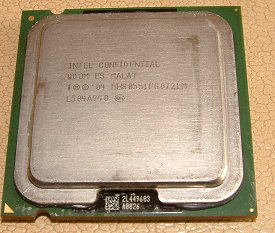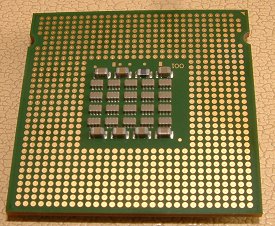Pentium D 820
Intel Pentium D 820I was also fortunate enough to take a look at Intel's all-singing, all-dancing, wallet-hurting Pentium Extreme Edition 840 processor a short while back. Right now, it's the only Pentium dual-core (Smithfield) CPU that supports Hyper-Threading, meaning that you can potentially have 4 threads executing at one time.
Better suited to most users' pockets will be a trio of dual-core CPUs without HT tech that all go by the moniker of Pentium D. The bottom of the pile, so to speak, is the Pentium D 820, which runs at 2.8GHz. Next up is 830, pushing along at 3.0GHz, and then there's 840, running at an XE-matching 3.2GHz but, and it bears repeating, without the joy that is Hyper-Threading.

Ye olde block diagram spils the beans. Intel's Smithfield lineup has two cores on a single die. As you can clearly see, each core has access to its own 1MB of L2 cache but both core share the same system bus, so memory bandwidth implications come more into play here than on a single-core setup. There's also the extra goodies that make it on to the Pentium 4 670, namely EIST, C1E and TM2 for power-saving, 64-bit ISA for you know what, and Execute Disable Bit.
Intel's dumbed down the Pentium D line by withholding Hyper-Threading support. It, supposedly, is why the Extreme is extreme and the far cheaper Pentium D 840 a not-so-extreme CPU. However, with 2 cores on a single CPU that can tackle a thread at the same time, Hyper-Threading won't be as missed as it would have been if absent on a single-core model, especially if you don't run more than a couple of CPU-intensive programs at any one time.
Intel hopes the clinching factor for the Pentium D 820 is its attractive price, which is scheduled at around £200. Ally that to a cheap-ish motherboard, say, any derivative of the 945-series and it's dual-core action on the (relatively) cheap. AMD, on the other hand, is comfortable with the performance of its single-core S939 CPUs, so the X2 range starts and finishes at the top-end of the market.
It's abundantly easy to see where the Pentium D 820 will succeed and fail, if judged by single-core models. Applications that are multi-threaded in nature will fly along, with 2 individual cores each executing concurrently. Think of professional apps. and various media encoding activities. Single-threaded applications will only be able to make use of part of each processor's ability, so, for example, gaming won't be Pentium D's strongpoint. It'll run like a 2.8GHz 600-series CPU, if one existed. More importantly than ever, you need to evaluate your primary uses and then select the appropriate CPU. The Pentium D 820 has a TDP of around 95W. It hit around 58c when under OS load and cooled by Intel's reference heatsink/fan combination.


Intel Confidential strikes again. Trust me, it's a Pentium D 820.

2 physical processors but no extra pair of logical ones as would be the case if Hyper-Threading was enabled.









